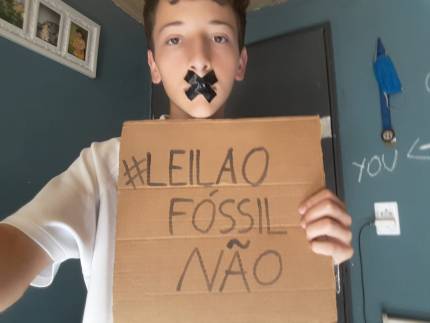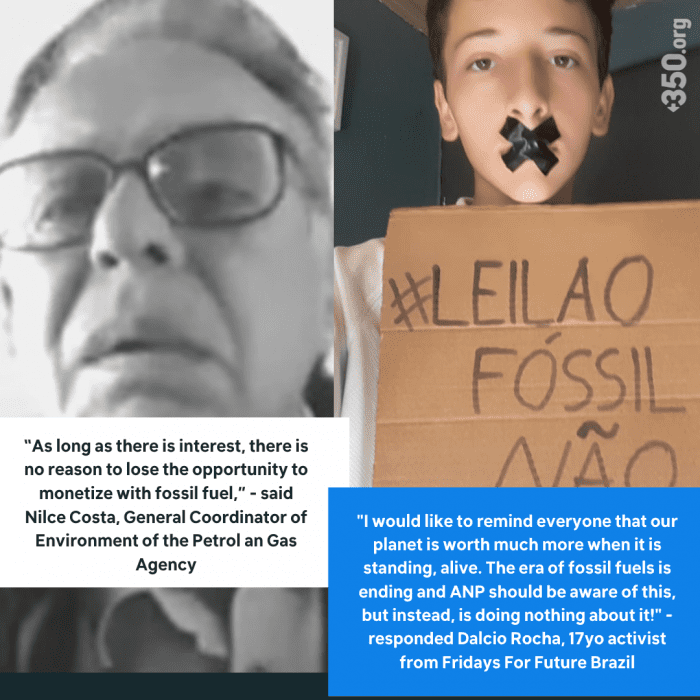
Last Wednesday, on an online event led by the National Agency of Oil and Gas (ANP), a Public Hearing was held to discuss the inclusion of hundreds of oil and gas exploration blocks in a permanent auction which, if approved, would make the blocks available to anyone interested — as if it was an outlet sale.
With a packed representation of ANP members, the only people representing civil society that were able to speak during the event were Ilan Zugman, director of 350. org Latin America, and Fridays For Future Brazil’s Dalcio Costa Rocha — both at the end of the hearing and exposing the lack of the legal precepts that should exist during a public hearing. Zugman highlighted that other organizations had signed up to speak at the event but had not been approved as exhibitors. He also criticized the fact that there was nobody speaking for traditional peoples and communities, despite being the ones most impacted by the result of oil and gas exploration.
“I would like to express my total repudiation of this type of permanent bid auction. We are talking about areas distributed throughout the country by land and sea, in extremely sensitive areas. More than a thousand blocks will impact not only our biomes and climate but also the livelihood of traditional peoples and communities. It seems that Brazil is not observing what is happening in all parts of the world, especially in the United States and Europe., I see people from Total, Exxon, Chevron, and Shell here in the meeting, and I want to send them a message to these investors and oil companies:
I imagine you have seen what happened with Shell last week. It was ordered by the Hague court to reduce its emissions, Or what happened to Exxon Mobil, losing participation within its own board, being forced to reduce emissions as well, and many other important facts such as theInternational Energy Agency issuing a report two weeks ago which states that to be able to keep the planet at 1.5°C warm increase — and in a healthy environment for future generations — we cannot have, from this year on, any new investments in oil, gas, and coal. So, my message to you, investors, financiers, and fossil fuel companies: civil society will do everything possible to avoid these blocks from being acquired. And if they do, we will resist and delay the licensing of these blocks as long as we can, so that they become increasingly unworkable and with fewer and fewer investors,” said Zugman in his speech.
In a stunning attempt to defend itself, ANP’s response was shameful, saying that there’s true “an irreversible path of change in the energy scenario”, but they still see interest from investors.
“As long as there is interest, there is no reason to miss the opportunity to make money,” said ANP’s Environment Coordinator Nilce Costa.
But right after Costa’s response, a young activist from Fridays For Future Brazil, Dalcio Rocha, had just the perfect reason to protect its generation from fossil fuel exploration:
“I would like to remind everyone that our planet is worth much more when it is standing, alive. The era of fossil fuels is ending and the ANP should be aware of this, but is not doing anything about it! – responded Dalcio Rocha from Fridays for Future Brazil

Each drilling in Brazilian soil or sea directly impacts the lands and the lives of thousands of families who depend on natural resources free of oil and gas contamination to survive — not to mention the millions of Brazilians who depend on surface and deepwater resources to maintain their economies and have quality water to drink.
If permanent blocks are added to the already available blocks that are being discussed in the public hearing, there will be a total of 1,068 blocks throughout the Brazilian territory. These are 522 blocks in onshore basins – in more than 10 Brazilian states and 546 blocks in offshore basins – almost the entire coastline of the country.
Among the onshore blocks, 61 are in the Legal Amazon, meaning:
- 23 indigenous territories will be directly impacted as they are at derisory distances from some of the blocks, and others completely surrounded by blocks;
- 17 conservation units will be directly impacted also because they are less than 5km from the blocks, and one of the blocks is inside a conservation unit;
- 2 quilombola communities will be directly impacted, because they border on one block and another because it is inside a block;
- There are possible impacts on the largest rivers and aquifers in the world: Amazon River and Alter do Chão Aquifer;
- There are countless priority areas for biodiversity conservation that will be impacted.
In a letter, the chief Ninawa Huni Kuin asked authorities not to allow oil and gas exploration in the Amazon.
“The Amazon has great importance for us and for all humanity. We cannot see Amazon only as a business product. It is so important that it represents life worldwide. It is unacceptable that projects like oil and gas prospecting have a greater value than life itself.
When the Amazon forest is exploited, it only does good for banks and companies’ pockets. while destroying life, animals, and ancient medicine. Economic interests from the government push destruction in the name of “development” for a few while leaving a trail of destruction that will not be restored.”, says the indigenous leader in these letter
Representative of the Guanabara Bay artisanal fishing community, Alexandre Anderson, president of AHOMAR also speaks out:
“Just the circulation of the ships necessary for exploration would already damage the activity of artisanal fishing, which employs so many people in the region. In addition, we know that small spills are not uncommon in the extraction areas, which would cause enormous damage to the communities,” says Anderson.
Permanent offer blocks: a study
At the public hearing last Wednesday, 377 blocks located in 72 sectors in 17 Brazilian sedimentary basins were discussed — 72 blocks are in onshore basins and 305 blocks in offshore basins.
Within blocks, research shows that just in the Legal Amazon region:
- 8 blocks are in the Amazonas Basin (Amazonas and Pará), being less than five kilometers from 3 Indigenous territories and conservation units;
- 20 blocks are in the Parecis Basin (Mato Grosso): less than five kilometers from 7 Indigenous Territories, with 2 territories completely surrounded by 4 blocks. In addition, 6 conservation units are less than five kilometers from the blocks;
- TOTAL: 10 Indigenous Territories and 9 Conservation Units will be very close to the blocks (less than 5km).
In addition, there are blocks that are already in permanent offer — 691 blocks located in 51 sectors in 15 Brazilian sedimentary basins, resulting in 247,483.543 km² of auctioned area, with 450 blocks in onshore basins and 241 blocks in offshore basins.
In a closer look at the Legal Amazon:
- 13 blocks are under the Amazonas Basin (Amazonas): less than five kilometers from 6 Indigenous Territories and 8 Conservation Units, with one block being within a fully protected conservation unit;
- 21 blocks are under the Parnaíba Basin (Maranhão): less than five kilometers from 7 Indigenous Territories, with one block being within a quilombola community and bordering another;
- TOTAL: 13 Indigenous Territories, 8 Conservation Units, and 2 quilombola communities very close to the blocks running serious risks of direct impacts.
It is also worth noting that, even under the scrutiny of the judiciary, the Camamu-Almada block (block near Abrolhos) continues as a permanent offer.
Unfortunately, the Amazon Forest, the region of Pantanal, Northeast Brazil, Abrolhos, Rio de Janeiro, the Atlantic Forest — all important areas of artisanal fishing in the South —, are a source of pride for Brazilians, and they risk being impacted by the oil and gas industry.
The country risks becoming a big Swiss cheese with so much drilling, because, once again, the National Oil and Gas Agency (ANP), puts the limits of climate, life, and environmental balance in check.
Check these maps:
We mapped the blocks made available by the ANP’s Permitted Offering in the Legal Amazon and crossed them with Indigenous Territories and Conservation Units. Check out the areas and territories impacted by the agency’s decision.
Click here to see the full map of Indigenous Territories in threats
Click here to see the map of Conservation Units in threats


0 Commentaires